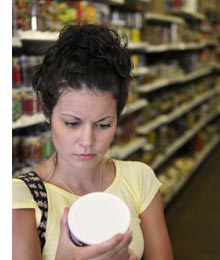What’s in a Name?
- By Charlene Oldham
- Last Updated On
- Reading Time: 3 mins.
Labeling Claims Cause Confusion in “Natural” Market
Natural. Sustainable. Organic. Beneficial. Whole grain. Gluten-free. Cage-free. GMO-Free. Local. Consumers are constantly enticed by labeling on products that promise a level of health for themselves and the environment, often paying a premium for them. But what do these words really mean? And is anyone watching for truth in advertising?

The Food and Drug Administration regulates health claims for product labels and advertising. For example, a product can be labeled as “natural” as long as it does not contain added color, artificial flavors, or synthetic substances.
In his work collecting data from food packaging, Dagan Xaiver, the chief administrative officer for FoodEssentials, has come across 30,000 different ways food makers and marketers claim their product is “natural.” Even food claims strictly regulated by the U.S. Department of Agriculture such as “Certified Organic” and “Gluten-Free” may not be as clear as they seem.
“We have over 15,000 different ways a product can say ”˜gluten free,’ which is a regulated claim,” said Xavier, whose company collects and analyzes food label data for consumers, manufacturers, retailers, and the government with the aim of making labels easier to understand. “Even with standardized claims, there are a lot of different ways to say the same thing.”
And many of the claims made most often by food manufacturers are virtually unregulated by the FDA, partly because the agency lacks the funding and manpower to investigate mislabeling cases, and partly because few hard-and-fast rules exist when it comes to many common claims, according to advocacy groups. So a package that proclaims its contents are all-natural, sustainable, or contain beneficial antioxidants could really be packed with little more than marketing muscle.
Want fruit for your office?
Get your office a free sample TODAY!“The call for a legal definition for ‘natural’ has been made for many years,” said David Schardt, senior nutritionist for the Center for Science in the Public Interest, non-profit nutrition, and food safety advocacy group. “It’s a tough word to define because it can mean many things. Meanwhile, FDA is understaffed and underfunded for the job it has been given, and ”˜natural’ is not killing anyone.”
And while it’s probably true that consuming food with a misleading or untrue “natural” label won’t adversely impact consumers’ health, the same can’t be said for their pocketbooks. The market for natural and organic food products reached $31 billion in 2007, up from $28.2 billion in 2006, according to the Nutrition Business Journal. In the same year, consumer sales of certified organic food products grew from $16.7 billion to $20 billion.
Consumers Don’t Understand
 Recent research indicates many consumers don’t understand the distinction between a food labeled as “natural” and products that bear the strictly regulated “USDA Organic” seal. In fact, the Food Marketing Institute reported last year that a survey showed “a lot of overlap in shoppers’ minds about natural, organic and locally grown foods, as evidenced by the fact that nearly the same number feel all three types of foods are healthy; 77 percent say so about organic, 76 percent about all-natural, and 78 percent about locally grown.”
Recent research indicates many consumers don’t understand the distinction between a food labeled as “natural” and products that bear the strictly regulated “USDA Organic” seal. In fact, the Food Marketing Institute reported last year that a survey showed “a lot of overlap in shoppers’ minds about natural, organic and locally grown foods, as evidenced by the fact that nearly the same number feel all three types of foods are healthy; 77 percent say so about organic, 76 percent about all-natural, and 78 percent about locally grown.”
Consumers have become more active in the labeling right to know movement. Prop 37, a 2012 California ballot initiative that would have required food producers to label GMOs and genetically engineered ingredients (among other labeling requirements) was narrowly defeated after huge spending by food producers, and packing and marketing companies that opposed it. (More than 60 countries already require labels for GMO ingredients.) See “Are you eating GMO foods?” to learn more.
Colorful front-of-the-box labels and packages plastered with pictures of fresh fruits and vegetables feed into the belief that what’s inside is good for you. These messages certainly stand out more than the FDA-regulated data in the black-and-white Nutritional Facts panel. While some farmers and food industry experts contend the USDA has done too much to co-opt the organic label, others argue that it is at least a regulated and definable standard, unlike so many other product labels.
“USDA has given ‘organic’ a strict and verifiable definition that consumers can rely on,” Schardt said.
Want fruit for your office?
Get your office a free sample TODAY!Charlene Oldham is a St. Louis-based writer.
Recent Articles
8 Avocado Varieties To Try (And When to Taste Them!)
When to Send Snack Care Packages to Employees: An HR Guide
The FruitGuys Delivers Fresh Groceries to 200 Federal Workers
Work Better With KiZE Bars: Clean-Ingredient Office Treats That Give Back
Farm-Fit Brings Fresh, Locally Sourced Produce to Campus
Subscribe to our Newsletter
"*" indicates required fields



